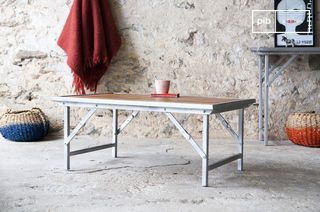Teak coffee tables
Teak coffee tables introduce a dense, stable material into the heart of the living room. This hardwood, naturally oiled, has a warm hue and marked veins, visible on every top. A teak coffee table finds its place in a sober or contrasting environment, with or without a rug. Its visual mass, assertive but not excessive, helps to structure a relaxation area without adding secondary elements. Resistant to repeated use, teak is ideal for an active living area that requires no special treatment. This furniture is long-lasting, both practically and visually.
read more >Filters

Teak coffee tableBollène
£555 £500-10%

The visual contributions of a teak coffee table
A teak coffee table stands out for the materiality of its top. The wood has a naturally warm color, oscillating between dark honey and deeper browns depending on the cut and ageing. The veins are visible, sometimes irregular, reinforcing the unique character of each piece. This visual identity allows teak to act as a focal point in both refined and highly-composed settings.
Unlike clear or translucent materials, teak does not stand out visually. It introduces a central mass into the living room, stable and legible. Wood retains this legibility even when combined with carpet, parquet or waxed concrete surfaces. This makes it a pertinent choice in rooms where contrasting materials contribute to the overall balance.
Possible uses, formats and layouts
A teak coffee table serves the same functional purposes as any central piece of furniture: accommodating everyday objects, supporting a serving tray, organizing a reading or resting area. The density of the wood means that heavy elements can be placed on it without risk of deformation, allowing repeated use over the long term. In a domestic context, it remains stable, even under frequent use.
The available formats are suited to a variety of needs. A rectangular top is suitable for elongated lounges or linear sofas. Square models promote centrality in a symmetrical room, while round teak tables offer a softer solution for open or shared spaces. Some models combine solid teak with a metal frame, lightening the overall look while retaining the warmth of the wood.
In terms of layout, teak requires a minimum of clearance around it. It's advisable to keep a clear space on the sides to enhance the tabletop and facilitate circulation. The addition of low seats or footstools can extend the convivial function of the table without breaking the visual unity.
Teak: a durable material for everyday use
Teak is a wood that is naturally resistant to moisture, temperature variations and minor impacts. Originally used in shipbuilding, today it retains these properties without intensive chemical treatment. For interior use, it requires no complex maintenance: regular dusting and occasional cleaning with a slightly damp cloth are all that's needed to preserve its appearance. It can also be oiled from time to time to revive its color, depending on the desired effect.
As a solid material, teak has a considerable weight. This density contributes to the furniture's stability, particularly in single-top configurations without reinforcement. However, it is advisable to take this weight into account when setting up the table, particularly if it is moved regularly or installed on a fragile floor.
Some models made from recycled teak present additional irregularities: traces of assembly, corking, or old marks. These elements may be visible but do not affect use. In short, the teak coffee table combines legibility, stability and simplicity of use. It provides a structuring focal point in the room without resorting to superfluous effects. Its dense, stable and self-contained material makes it a durable piece of furniture, both functionally and aesthetically.